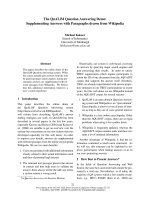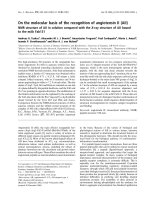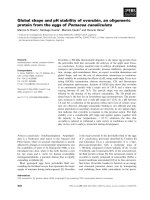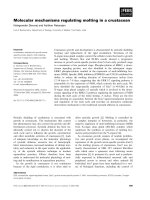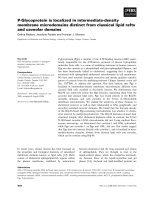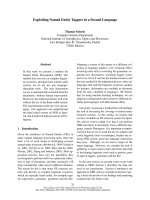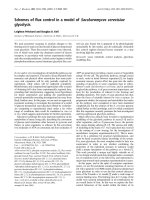báo cáo khoa học: " Flare hypercalcemia after letrozole in a patient with liver metastasis from breast cancer: a case report" pot
Bạn đang xem bản rút gọn của tài liệu. Xem và tải ngay bản đầy đủ của tài liệu tại đây (281.34 KB, 4 trang )
CAS E REP O R T Open Access
Flare hypercalcemia after letrozole in a patient
with liver metastasis from breast cancer:
a case report
Katsumasa Kuroi
1*
, Toshinari Yamashita
1
, Tomoyuki Aruga
1
, Kazumi Horiguchi
1
, Dai Kitagawa
1
, Susumu Sekine
1
,
Hiromi Tokita
1
and Yuka Hirashima
2
Abstract
Introduction: Tamoxifen may occasionally precipitate serious and potentially life-threatening hypercalcemia.
However, to date, this has not been docume nted with aromatase inhibitors.
Case presentation: A 65-year-old Japanese woman with liver metastasis from breast cancer was admitted to our
hospital with vomiting, anorexia, fatigue, arthralgia, muscle pain and dehydration. She had started a course of
letrozole five weeks earlier. Our patient’s calcium level was 11.6 mg/dL. She was rehydrated and elcatonin was
administered. Our patient’s parathyroid hormone and parathyroid hormone-related protein levels were not
increased and a bone scintigram revealed no evidence of skeletal metastasis. After our patient’s serum calcium
level returned to within the normal range, letrozole was restarted at one-half of the previous dose (1.25 mg). There
were no episodes of hypercalcemia. However, 84 days after restarting letrozole, our patient again complained of
arthralgia and treatment was changed to toremifene. During these periods, repeated ultrasonograms revealed no
progression of liver metastasis.
Conclusion: To the best of our knowledge, this is the first case report of flare hypercalcemia after treatment with
letrozole in a patient with metastatic breast cancer.
Introduction
Flare reaction, a transient exacerbation of symptoms,
has been described primarily in breast cancer treatment
with tamoxifen and in prostate cancer following therapy
with luteini zing hormone-releasing hormone analogues
[1,2]. However, the association between a flare reaction
and aro matase inhibitors (AIs) has not been documen-
ted. We report a case of hypercalcemia that occurred 37
days after initiation of letrozole in a patient with liver
metastasis from breast cancer.
Case presentation
A 65-year-old Japanese woman was admitted to our
hospital one year ago with vomiting, anorexia, fatigue,
arthralgia, muscle pain, and dehydration (Figure 1). Our
patient had undergone a right mastectomy 30 years pre-
viously and received adjuvant chemoendocrine therapy
(doxifluridine and t amoxifen) without complications.
Five y ears after that surgery, she developed a tumor in
her liver and a needle biopsy revealed metastatic adeno-
carcinoma from breast cancer (e strogen-receptor posi-
tive, progesterone-receptor positive, Her2 negative).
Since then, our patient has been treated with taxanes
and capecitabine, followed by doxifluridine and medrox-
yprogesterone acetate. Using doxifluridine and medroxy-
progesterone acetate, she remained well and achieved a
complete response without an increase of carcinoem-
bryonic antigen (CEA) or carbohydrate antigen (CA) 15-
3 for eight years. However, three months before this
current admission, CEA and CA 15-3 had increased to
6.3 ng/mL (normal value < 5 ng/mL) and 30.6 IU/mL
(normal value < 23 IU/mL) respectively and an abdom-
inal ultrasonogram revealed recurrence of liver metasta-
sis. A computed tomography (CT) scan was normal.
Letrozole was initiated with alendrona te (T score -2.8)
* Correspondence:
1
Department of Surgery, Tokyo Metropolitan Cancer and Infectious Diseases
Center Komagome Hospital, 3-18-22 Honkomagome, Bunkyo-ku, Tokyo 113-
8677, Japan
Full list of author information is available at the end of the article
Kuroi et al. Journal of Medical Case Reports 2011, 5:495
/>JOURNAL OF MEDICAL
CASE REPORTS
© 2011 Kuroi et al; licensee BioMed Central Ltd. Thi s is an Open Access article distributed under the terms of the Creative Commons
Attribution License ( which permits unrestricted use, distribution, and reproduction in
any medium, provided the original work is properly cited.
and withdrawn three weeks later due to severe muscle
pain and arthralgia. Two weeks after the onset of these
symptoms, the severity increased and our patient was
admitted to our hospital. Her serum calcium level was
11.6 mg/dL. She was rehydrated and elcatonin was
administered. Parathyroid hormone (PTH) and parathyr-
oid hormone-related protein (PTHrP) levels were not
increased and a bone scintigram, CT and thoracolumbar
survey revealed no evi dence of skeletal metastasis. Intra-
venous bisphosphonate was not administered as our
patient had been undergoing dental tre atment. She was
discharged when symptoms subsided on day 11. One
week later, after the completion of her dental treatment,
our patient was administered zoledronate for persistent
hypercalcemia. Thereafter, our patient was readmitted
due to hypocalcemia. After our patient’s serum calcium
6
HUXPFDOFLXP
PJG
&($QJPO
&$8PO
'D
\
VIURPWKHVWDUWRIOHWUR]ROH
/HWUR]ROHPJ /HWUR]ROHPJ
7RUHPLIHQHPJ
=ROHQGURQDWHPJ
Figure 1 Changes in serum calcium level and tumor markers before and after flare hypercalcemia. The normal range of serum calcium
level was 8.4 mg/dL to 9.7 mg/dL (this was changed to 8.5 mg/dL to 10.2 mg/dL at midstream), and the calcium level was corrected with
albumin by a standard calculation.
Kuroi et al. Journal of Medical Case Reports 2011, 5:495
/>Page 2 of 4
levels returned to within normal range, letrozole was
restarted at one-half dose (1.25 mg) with no reoccur-
rence of hypercalcemia. Unfortuna tely, 84 days after the
restart, letrozole was withheld due to intolerable arthral-
gia and our patient’s therapy was changed to toremifene.
Although she complained of mild arthralgia while on
toremifene, the symptom gradually subsided and she has
remained well. Repeated ultrasonograms revealed no
progression of liver metastasis. Our patient’sCEAand
CA 15-3 have again increased to pretreatment levels but
have remained stable.
Discussion
A flare reaction was first observed during the treatment
of postme nopausal women with high-dose estrogen and
has been frequently documented with tamo xifen [1,3].
This reaction comprises two different manifestations:
tumor flare and flare hypercalcemia [2]. The former
includes an increase in swelling, erythema, itching, or
pain in soft-tissue metastasis, the development of new
lesions, an increase of tumor markers and an increase in
skeletal pain in patients with bone metastasis. Tumor
flare can be accompanied by flare hypercalcemia.
The distinction between spontaneous hypercalcemia
and f lare hypercalcemia is sometime s difficult to ascer-
tain. Although both occur most often in patients with
widespre ad bone metastases [4,5], flare hypercalcemia
can be seen in patients without apparent bone involve-
ment [6,7], as in the case of our patient. Moreover, flare
hypercalcemia has a rapid onset that characteristically
occurs within several days of starting therapy; symptoms
are usually short- lived and serum calcium levels return
to normal when the offering agent is withdrawn. In con-
trast, spontaneous hypercalcemia is generally slow i n
onset and, accordingly, symptoms develop g radually
[1,8]. In general, the following three criteria are used to
prove a causal relation between drug and symptom: the
symptom should develop after drug administration,
reverse when it is withdrawn, and be reinduced by
rechallenge [9]. In this res pect, flare hypercalcemia
could meet two of these three criteria. Similar to other
reports of flare hypercalcemia [5,6,8-11], the third criter-
ion is not met in the case of our patient; however, the
temporary relation of the onset of hypercalcemia and
administration of let rozole strongly suggests a causal
role for the drug.
Our review of the literature did not reveal any descrip-
tion of flare hypercalcemia by AIs with the exception of
one report of tumor flare and tumor lysis syndrome by
letrozole. In a study by Zigrossi et al. [12], a 61-year-old
woman experienced tumor flare (pleural and pericardial
effusion) and tumor lysis syndrome on the second day of
letrozole administration and subsequent ly recovered
from critical condition, notwithstanding continuation of
letrozole. Tumor lysis syndrome is characterized by the
rapid death of neoplastic cells that develops soon after
effective therapy. The biochemical and clinical features of
this syndrome include hyperazotemia, hyperuricemia,
hyperkalemia, hypocalcemia, elevated lactate dehydro-
genase, hypotension and acute renal failure. The patient
in the study did not develop hypercalcemia.
The exact mechanism of flare hypercalcemia remains
uncertain, and it is believed that estrogenic properties of
tamoxifen may precipitate hypercalcemia in tamoxifen-
induced hypercalcemia. Although this does not account
for AIs, it is interesting to note th at flare hypercalcemia
could occur in estrogen-receptor negative patients [9].
Thus, it might be plausibl e to consider that flare hyper-
calcemia is due t o increased osteocla st activities and
bone resorption caused by the increased release of var-
iou s factors from the tumor or host cells by the offend -
ing drug [7,11,13]. Importantly, normal PTH and/or
PTHrP levels in our patient exclude the possibility of
coexisting primary hyperparathyroidism and ectopic
secretion of PTH and/or PTHrP caused by tumor cells.
Another cause of hypercalcemia might include inappro-
priately increased production of 1, 25-hydroxyvitamin
D3 typically seen in patients with lymphomas or sar coi-
dosis [7]. However, the vitamin D3 levels were not
assessed and CT and clinical findings did not suggest
the possibility of these conditions as a cause of flare
hypercalcemia in our patient.
It is difficult to predict and to prevent flare hypercalce-
mia, but life-threatening hypercalcemia should be treated
intensively by stopping the offending drug, rehydration
and bisphosphonate treatment [13,14]. As for rechallenge
of the offending drug, it is usually suggested that, if
necessary, tamoxifen be resumed temporarily at a lower
dosage in tamoxifen-induced hypercalcemia. This is
because tumor regression could occur after the flare
reaction subsides and the survival of patients with tamox-
ifen-induced hypercalcemia is reported to be longer than
that of patients with spontaneous hypercalcemia
[1,2,8,15]. This strategy also appears to apply to AIs [12].
Conclusion
Our experience suggests that AIs may precipitate serious
and potentially life-threatening hypercalcemia in the
early stages of treatment. If this occurs, AIs could be
restarted cautiously with therapeutic benefit. To our
knowledge, the association of hypercalcemia and AIs has
not been previously reported.
Consent
Written informed consent was obtained from the patient
for publicatio n of this case report and any accompany-
ing images. A copy of the written consent is available
for review by the Editor-in-Chief of this journal.
Kuroi et al. Journal of Medical Case Reports 2011, 5:495
/>Page 3 of 4
Author details
1
Department of Surgery, Tokyo Metropolitan Cancer and Infectious Diseases
Center Komagome Hospital, 3-18-22 Honkomagome, Bunkyo-ku, Tokyo 113-
8677, Japan.
2
Department of Pharmacy, Tokyo Metropolitan Cancer and
Infectious Diseases Center Komagome Hospital, 3-18-22 Honkomagome,
Bunkyo-ku, Tokyo 113-8677, Japan.
Authors’ contributions
TY, TA, KH, DK, SS, HT analyzed and interpreted the patient data regarding
the hypercalcemia. YH collected the clinical data and reviewed the literature
about flare. KK was the doctor in charge and was a major contributor in
writing the manuscript. All authors read and approved the final manuscript.
Competing interests
The authors declare that they have no competing interests.
Received: 15 June 2011 Accepted: 4 October 2011
Published: 4 October 2011
References
1. Ellis MJ, Hays DF, Ellis LM: Treatment of metastatic breast cancer. In
Disease of the breast. Edited by: Harris JR, Lippman ME, Morrow M, Osborne
CK. Philadelphia: Lippincott Williams 2004:1101-1159.
2. Clarysse A: Hormone-induced tumor flare. Eur J Cancer Clin Oncol 1985,
21(5):545-547.
3. Plotkin D, Lechner JJ, Jung WE, Rosen PJ: Tamoxifen flare in advanced
breast cancer. JAMA 1978, 240(24):2644-2646.
4. Davis HL Jr, Wiseley AN, Ramirez G, Ansfield FJ: Hypercalcemia
complicating breast cancer. Clinical features and management. Oncology
1973, 28(2):126-137.
5. Patterson JS, Furr BJ, Battersby LA: Tamoxifen and hypercalcemia. Ann
Intern Med 1978, 89(6):1013.
6. Bezwoda WR, Derman D, Zaltzman M, de Moor NG, Lange M: Tamoxifen
and hypercalcaemia. A case report. S Afr Med J 1980, 58(20):821-822.
7. Santarpia L, Koch CA, Sarlis NJ: Hypercalcemia in cancer patients:
pathobiology and management. Horm Metab Res 2010, 42(3):153-164.
8. Legha SS, Powell K, Buzdar AU, Blumenschein GR: Tamoxifen-induced
hypercalcemia in breast cancer. Cancer 1981, 47(12):2803-2806.
9. Pritchard KI, Clark RM, Fine S, Meakin JW, Perrault DJ, Sutherland DJ:
Tamoxifen and hypercalcemia. Ann Intern Med 1978, 89(3):423-424.
10. Spooner D, Evans BD: Tamoxifen and life-threatening hypercalcaemia.
Lancet 1979, 2(8139):413-414.
11. Arumugam GP, Sundravel S, Shanthi P, Sachdanandam P: Tamoxifen flare
hypercalcemia: an additional support for gallium nitrate usage. J Bone
Miner Metab 2006, 24(3):243-247.
12. Zigrossi P, Brustia M, Bobbio F, Campanini M: Flare and tumor lysis
syndrome with atypical features after letrozole therapy in advanced
breast cancer. A case report. Ann Ital Med Int 2001, 16(2):112-117.
13. Nikolic-Tomasevic Z, Jelic S, Popov I, Radosavljevic D, Mitrovic L: Tumor
‘flare’ hypercalcemia–an additional indication for bisphosphonates?
Oncology 2001, 60(2):123-126.
14. Lumachi F, Brunello A, Roma A, Basso U: Medical treatment of
malignancy-associated hypercalcemia. Curr Med Chem 2008,
15(4):415-421.
15. de Wit S, Cleton FJ:
Hypercalcemia in patients with breast cancer: a
survival study. J Cancer Res Clin Oncol 1994, 120(10):610-614.
doi:10.1186/1752-1947-5-495
Cite this article as: Kuroi et al.: Flare hypercalcemia after letrozole in a
patient with liver metastasis from breast cancer: a case report. Journal
of Medical Case Reports 2011 5:495.
Submit your next manuscript to BioMed Central
and take full advantage of:
• Convenient online submission
• Thorough peer review
• No space constraints or color figure charges
• Immediate publication on acceptance
• Inclusion in PubMed, CAS, Scopus and Google Scholar
• Research which is freely available for redistribution
Submit your manuscript at
www.biomedcentral.com/submit
Kuroi et al. Journal of Medical Case Reports 2011, 5:495
/>Page 4 of 4

